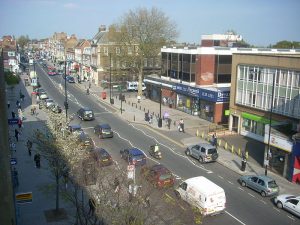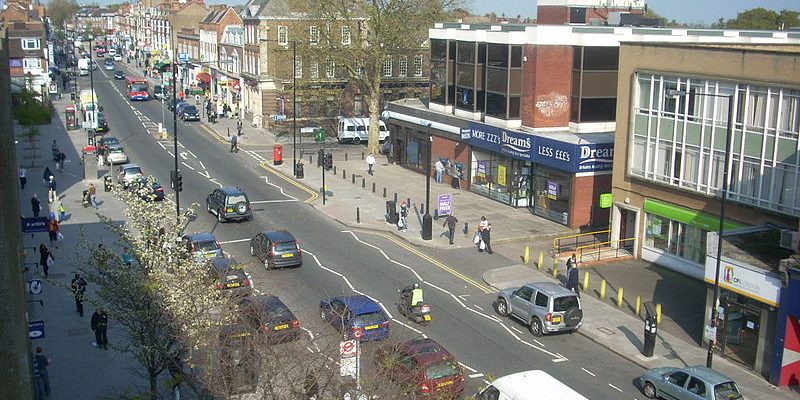Transfer from Finchley Central (N3) to Heathrow Airport
 Finchley is a districtin Barnetin north London, England. Finchley is on high ground, about 11 km (6.8 mi) north of Charing Cross. It formed an ancient parish in the county of Middlesex, becoming a municipal borough in 1933, and has formed part of Greater London since 1965. It is predominantly a residential suburb, with three town centres. In case your are looking for Taxi Transfer from Finchley Central(N3) to Heathrow Airport, there are plenty of options.
Finchley is a districtin Barnetin north London, England. Finchley is on high ground, about 11 km (6.8 mi) north of Charing Cross. It formed an ancient parish in the county of Middlesex, becoming a municipal borough in 1933, and has formed part of Greater London since 1965. It is predominantly a residential suburb, with three town centres. In case your are looking for Taxi Transfer from Finchley Central(N3) to Heathrow Airport, there are plenty of options.
Finchley probably means Finch’s clearing or finches’ clearing in late Anglo-Saxon; the name was first recorded in the early 13th century. Finchley is not recorded in the Domesday book, but by the 11th century its lands were already included in those of the Bishop of London. In early medieval period the area was sparsely populated woodland. During the 12th and 13th century proper farming began, and by the 15th and 16th century the woods on the eastern side of the parish were cleared to form Finchley Common. The medieval Great North Road, which ran through the common, was notorious for Highwaymen until the early 19th century. In the 1270s the parish church of St Mary is first recorded. The settlement at Church End grow up around it. Near the northern gate to the Bishop of London’s park the hamlet of East End, later East Finchley had begun to develop by 1365. The Edgware, Highgate and London Railway (later the Great Northern Railway) reached Finchley in 1867. The route ran from Finsbury Park via Finchley to Edgware. The High Barne branch opened from Finchley in 1872.
In 1905 tram services were established in Finchley, and extended shortly after to Barnet. They were eventually replaced by trolley buses.
In 1933, the Underground New Works Programme 1935-1940 was announced, to electrify the lines through Finchley, and connect the Underground from Archwayto East Finchley, via a new tunnel.
Much of the work was carried out, with East Finchley station being completely rebuilt, until stopped by the Second World War. All passenger services from Finchley to Edgware ended in September 1939. Nevertheless, Underground trains began running from central London to High Barnet in 1940, and to Mill Hill East, to reach the large army barracks, in 1941.
After the war, the introduction of London’s Metropolitan Green Beltundermined pre-war plans, and the upgrading between Mill Hill East and Edgware (the ‘Northern Heights’ project) was abandoned, although the line continued to be used by steam trains for goods traffic through Finchley, until it closed completely in 1964.
Taxi Transfer from Finchley Central(N3) to Heathrow Airport – the best services
St Mary’s at Finchley is the parish church, with parts dating from 13th century. Avenue House is a large Victorian house (Grade II listed) situated on East End Road. College Farm is the last farm in Finchley, it was a model dairy farm, then a visitor attraction. The Phoenix Cinema in East Finchley with its 1930s art deco facade is one of the oldest purpose-built cinemas in the UK.
The Sternberg Centre for Judaism located in the old Manor House (formerly the convent and school of St Mary Auxiliatrice) at 80 East End Road in Finchley is a Jewish cultural centre. It was founded to facilitate a number of important Reform and Liberal Jewish institutions, attached to the Movement for Reform Judaism.
The Archer is a 10-foot-tall (3.0 m) statue by Eric Aumonierof a kneeling archer captured as if having just released an arrow. Located on East Finchley tube station. The statue La Delivrance depicts a naked women holding a sword, it stands at the approach to Finchley from the south, in Regent’s Park Road, just north of Henly’s Corner.
Veolia Water Central Limited, formerly Three Valleys Water, supplies Finchley’s water; the area is in the south-east corner of the company’s water supply area. EDF Energy Networks is the Distribution network operator licensed to distribute electricity from the transmission grid to homes and businesses in Finchley.
The Finchley Memorial Hospital, on Granville Road North Finchley, is a small NHS hospital administrated by NHS Barnet, a primary care trust. Built with local donations in 1908 it was originally called Finchley Cottage Hospital, but renamed and expanded after the First World War as a war memorial. London Ambulance Service responds to medical emergenciesin Finchley. Home office policing in Finchley is provided by the Metropolitan Police Service. Statuory emergency fire service is provided by the London Fire Brigade, which has a station on Long Lane.
Get your dedicated Heathrow airport transfer services
Being in Greater London Transport for London is responsible for transport in Finchley. Finchley is served by four London Underground stations, all on the High Barnet branch of the Northern Line.
East Finchley tube station in zone three, serves East Finchley and is 21 minutes from Charing Cross.
Finchley Centrl tube station in zone four, serves Finchley, Church End and is 25 minutes from Charing Cross.
West Finchley tube station in zone four, serves North Finchley and is 27 minutes from Charing Cross.
Woodside Park tube station in zone four, serves North Finchley and is 29 minutes from Charing Cross.
Two of London’s major roads, the east-westA406 North Circular Road and the north-south A1meet and briefly merge at Henly’s Corner at the southern edge of Finchley.
North Finchley serves as a major bus hub with nine buses using bus stops around Tally Ho Corner.
Otherwise, you can choose to take a taxi transfer from Finchley Central to Heathrow Airport. It will cost you almost 33 GBP and the journey will take around one hour.
Image source:Wikipedia..

